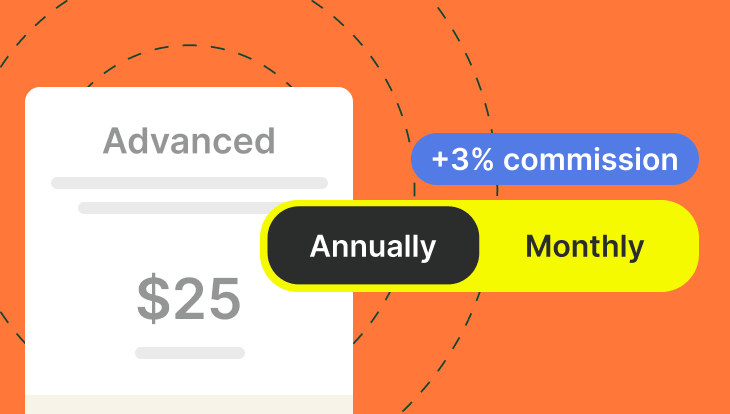More than 70% of SaaS companies offer both monthly and annual subscriptions.
That’s according to data sourced by Recurly, a subscription billing provider.
Despite this widespread practice, we’ve found many companies get stuck over how to compensate their sales reps for monthly versus annual contracts.
To help, we compiled some suggestions below.
Defining “monthly subscription”
The first thing to remember is that two different monthly subscription models exist, and people often use similar terminology to describe them.
Option 1: An annual subscription that the customer agrees to pay monthly.
Option 2: A true monthly model, like Netflix or Spotify, where the customer can cancel after any month without repercussion.
Commissions on annual agreements
In a traditional SaaS model, the customer signs an annual agreement that the business bills annually, quarterly, or monthly. This contract legally binds the customer to a 12-month payment, regardless of when it’s collected.
When the customer signs an annual contract, companies honor commissions in several ways.
One way they might pay commissions is by rewarding the entire earnings amount upon receiving the customer invoice for the total annual amount.
Design, track, and manage variable incentives with QuotaPath. Give your RevOps, finance, and sales teams transparency into sales compensation.
Talk to SalesFor context, we found that just 20% of companies paid commissions at the time of invoice, while 64% paid when the deal closed. However, in our conversations with customers and leaders from our communities (RevOps Co-op, Pavilion, Women in Sales) this past year, we expect these numbers to swap as cash flow needs have increased.
“In an early-stage startup, where free cash flow might be limited, and the product is more transactional, paying on collection makes sense,” said Carl Ferreira, Director of Sales at Refine Labs, in our blog, When should you set your sales commission payment terms for?
Alternatively, if your organization offers billing options, you could incentivize your reps to push for an annual payment upfront by paying a higher commission rate.
“I’ve seen companies pay 10% commissions for an annual payment upfront, then 9% if they agree to pay the amount in quarterly installments, and 8% on monthly payments,” said QuotaPath Chief of Staff Graham Collins. “Then you issue a clawback if the customer doesn’t fulfill the 12 months.”
Commissions on monthly subscriptions
Meanwhile, companies offering true monthly subscriptions have a few options to consider when honoring commissions.
They could pay the rep monthly, similar to a usage-based compensation plan, for the first 12 months. If the customer churns after 8 months, the rep stops earning commissions but does not have to pay back any previously earned commissions.
In this scenario, you’ll follow standard commission rates and pay it over the year.
“The downside with this model is that the new biz rep becomes an account manager,” said Graham. “The other issue is that reps can rest on their laurels if they secure a monthly deal that meets or exceeds their monthly quota.”
Another option entails paying the annualized value at a reduced rate, or half the commission rate, upfront. Then, if they don’t pay 6 months of it, you claw back the commissions.
If you go this route, set the rate by looking at the average length customers “stick around.” For instance, if most customers stay on for 9 months, then you’d pay ¾ the commission rate because, on average, they exit after three quarters.
Free Sales Commission Calculator Template
A free spreadsheet to simplify the commission tracking process. Track what you or your team have earned in 4 inputs.
Download NowQuestions?
For additional support, we’re here to help. Contact our team to learn how QuotaPath partners with organizations on their sales compensation strategies, including compensation plan design, commission management, and payments.
Or, skip the chat and head straight to experiencing our platform in a free trial of QuotaPath.



